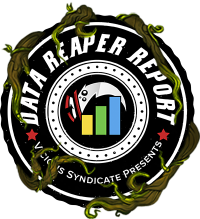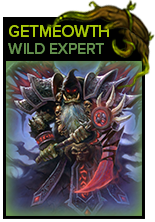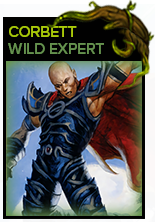
Welcome to the 33rd edition of the Wild Data Reaper Report! This report discusses the format following the 25.0.4 patch on December 19th.
Quick Links
Class/Archetype Distribution | Matchup Winrates | vS Power Rankings | Meta Score | Class Analysis & Decklists | How to Contribute | Credits
Number of Games
| Overall | 490,000 |
| Top 1K Legend | 32,000 |
| Legend (Excluding Top 1k) | 34,000 |
| Diamond 4 to 1 | 65,000 |
| Diamond 10 to 5 | 75,000 |
| Platinum | 71,000 |
| Bronze/Silver/Gold | 213,000 |
Class/Archetype Distribution
[TABS_PRO id=60815]
Rogue is one of the more popular classes in the format, and its popularity rises as you climb ladder. It’s primarily comprised of Pirate Rogue, with an increase of Pillager Rogue as you reach top legend. There is a little bit of Miracle Rogue too.
A similar story can be told of Shaman, where the population of the class rises at higher ranks. The Shaman class is comprised of its two long-established archetypes, Even Shaman and Shudderwock Shaman.
Mage is the most popular class at Diamond 5 and below. It consists primarily of two decks: Secret Mage and Quest Mage. Secret Mage dominates Diamond ranks where its play rate circles around 10%, but significantly declines at top legend near Quest Mage’s stable play rate of around 5-6%.
Priest’s play rate is stable throughout ladder, but the constitution slightly changes at top legend, where you see less Big Priest and more Shadow Priest. Reno Priest is seeing very consistent play throughout every rank bracket, from Bronze to top legend.
Druid is a popular class everywhere except top legend, with Ramp Druid seeing the most play. The Ramp Druid archetype itself is very messy, though, as players attempt to adapt to a nerfed Renathal with many different iterations.
Following the ban on Tome Tampering, Warlock is fractured into several archetypes that haven’t gained much traction. Disco and Reno Warlock are the most visible archetypes, but their play rate is quite low. Even and Curse Warlock can also be found.
Death Knight is understandably played as the new class, but its play rate doesn’t mirror its standard iterations. Most players are sporting similar decks to standard strategies, such as Blood-Ctrl and Frost-Burn, but we also have a wild-exclusive version of Death Knight, Unholy-Even, that a small portion of players have picked up on.
There is a significant drop-off to the bottom four classes. Hunter, Paladin, Demon Hunter, and Warrior attract little interest throughout ladder, and none of their decks have gained traction to become format staples. We’ll have to see whether some of their decks could be underrated sleepers.
[TABS_PRO id=60816]

[TABS_PRO id=60818]
vS Meta Score
[TABS_PRO id=60819]
The format is currently defined by the three pillar aggressive decks: Even Shaman, Pirate Rogue, and Secret Mage. Regardless of which rank you find yourself at, these three decks are performing extremely well and must be heavily considered when it comes to deck choices and card choices. However, there are unsolved elements in the format and some surprises.
Rogue
- Pirate Rogue is back amongst the most powerful decks in Wild, exhibiting Tier 1 performance throughout ladder. To say Pirate Rogue is enjoying a world where Renathal isn’t as widespread would be an understatement. The slight weakness to Even Shaman exists, but it looks comfortably favored against Secret Mage now.
- Miracle Rogue was expected to be dead in the water following the nerfs to Sinstone Graveyard and Draka, but much like in Standard, it looks capable of adapting. Its performance at top legend puts it at Tier 1 already, and we wouldn’t be surprised if further refinements and its high skill ceiling eventually land it as the #1 deck at higher levels of play. Its matchup spread is extremely promising against other Tier 1 decks.
- Pillager Rogue is another skill-testing deck that was finally able to crack Tier 2 at top legend in our last report. However, the nerf to Renathal resulted in many of Pillager Rogue’s favorable matchups falling off, as well as rise in oppressive matchups against aggressive decks. This has pushed Pillager Rogue’s performance back to the dumpster. It is not well equipped to deal with Even Shaman, Pirate Rogue, and worse of all, Secret Mage.
Shaman
- Even Shaman is the best performing deck in the format, as it is the Tier 1 aggressive deck that beats the other Tier 1 aggressive decks. You’ll have to rely on the defensive shells of Shudderwock Shaman or Control Warlock archetypes to consistently counter this deck.
- Shudderwock Shaman is a strong contender in the format and one that has the potential to improve through refinement. It has adapted well to the movement back to 30-card builds following the nerf to Renathal, but it hasn’t completed this transformation yet. It is the best counter to Even Shaman and the only notable counter to Miracle Rogue. However, Pirate Rogue and Secret Mage are tough opponents, so it can’t seem to break into Tier 1 in their presence.
Mage
- Secret Mage is the aggressive deck that serves as the strongest counter to slower strategies. It has unfavorable matchups against both Even Shaman and Pirate Rogue but punishes decks that attempt to counter them. Whether it’s a Reno deck, a Combo deck, or some other defensive deck, Secret Mage promises to be a tough opponent.
- In a format that has sped up with the new expansion and balance patch, Quest Mage suffers, as it has terrible matchups into many of the faster decks in the format.
Priest
- Reno Priest is one of the biggest losers of the expansion and subsequent balance patch. The Renathal nerf has hit it hard. It seems incapable of beating aggressive decks besides Pirate Rogue, while it remains a sitting duck to other late-game strategies with a faster clock. It’s Tier 4 everywhere on ladder.
- In another shift back towards normality, Big Priest is mediocre yet popular, sitting at Tier 2 at lower rank brackets before dropping to Tier 3 at Diamond 4 and above.
- Faster Priest decks, which are historically underplayed, are slept on. Divine-Spirit and Shadow Priest perform excellently, and neither is particularly refined. DS Priest is Tier 2 across all rank brackets. Shadow Priest is Tier 1 throughout most of ladder, and even at top legend it has a very promising matchup spread.
Warlock
- Disco Warlock was a format-defining deck that eventually led to the ban of Tome Tampering. Even after this ban, we’ve seen the deck perform at a very competitive level. There might be something here with a refined, post-ban list.
- Even Warlock has had a resurgence post-patch, competing at a Tier 2 level at all ranks. We encourage players to consider it if they’re looking for an Even Shaman counter. The main problem is Secret Mage.
- Curse Warlock wasn’t good enough pre-patch when slower decks were more popular, and Renathal was good. It’s obviously not going to do well now. Players need to revisit and redesign lists because current iterations aren’t working.
- Reno Warlock finds itself struggling to win games in the new meta. Much like Reno Priest, it’s completely stuck on Renathal. The archetype needs a reboot, perhaps a non-Renathal list focused on beating the top-tier aggressive decks. Currently, it does nothing well.
Druid
- Ramp Druid is another deck that needs to let Renathal go. The prince is weighing it down. The strategy shows more promise going back to 30-card builds and is likely better than it looks statistically. A Tier 3 placement, despite looking like one of the messiest archetypes in the format, isn’t too bad. There’s some hidden potential here.
Death Knight
- Death Knight has a very strong and competitive deck in Wild! Unholy-Even Death Knight is a Tier 1 deck across all rank brackets, exhibiting good matchups into other aggressive decks. It destroys Pirate Rogue, while keeping close matchups with Secret Mage and Even Shaman, so it’s well-positioned against the top three decks in the format. However, it does seem to have a terrible time facing strategies with huge power spikes, like Big Priest and Shudderwock Shaman, that blow out its ‘steady’ game plan. Considering it’s new and underexplored, it seems worth a shot.
Hunter
- Beast Hunter may no longer be the deck to beat in Wild, but it can still produce good results, so the class is not as bad as its play rate may suggest.
Paladin
- Aggro Paladin received a major shot in the arm with the most recent expansion, so its placement in the power rankings reflects that. Its matchup spread looks good against most of the field, but the difficult matchups into Even Shaman and Pirate Rogue are sore spots. Aggro Paladin appears destined to stay out of the elite pack if those decks continue to stick around in great numbers.
Warrior
- Let Pirate Warrior die. It’s had its run. Enrage Warrior might be okay based on its low sample size, but it’s hard to say confidently. Control Warrior is never good in this format.
Demon Hunter
- Quest Demon Hunter is no Miracle Rogue. It cannot handle this format at all. There are a lot of different Quest iterations, and they’re all very bad, much like any other Demon Hunter deck.
Class Analysis & Decklists
Death Knight | Demon Hunter | Druid | Hunter | Mage | Paladin | Priest | Rogue | Shaman | Warlock | Warrior
Pirate Rogue has become one of the most dominant decks in Wild. Although it was a strong performer during Nathria, it didn’t quite hold up at higher levels of play. That has now changed, with Pirate Rogue exhibiting an exceptional win rate at every rank bracket on top of being one of the most popular decks in the format.
The nerf to Renathal has been a huge positive for Pirate Rogue, but a few other differences on ladder have helped, such as its matchup against Secret Mage flipping. Pirate Rogue’s build remains solved, with no changes in several expansions.
In contrast, Pillager Rogue is in freefall. The meta has become increasingly aggressive, a nightmare for Wild’s most fragile glass-cannon combo deck. Even at higher levels of play, Pillager Rogue is languishing in Tier 4 after showing great promise last expansion. You can’t outplay your opponent if you’re dead.
There was an expectation that Miracle Rogue would die off after the nerfs to Necrolord Draka and Sinstone Graveyard. Although the deck’s play rate has been slashed as a reaction to the nerfs, its win rate at higher ranks looks very good. We suspect there may be further room for the archetype to improve and that Miracle Rogue would be the best deck in the format given refinement. Mailbox Dancer builds are most widely seen, but there have been very recent developments involving Maestra and Wildpaw Gnolls that look superior. Only Shudderwock Shaman is capable of consistently beating this deck at top legend.
Bomb Rogue has largely disappeared after the nerf to Sketchy Information but could be a somewhat competitive option.
Even Shaman is the apex predator of the format, the best aggressive deck that beats the other aggressive decks. It has the highest win rate across all of ladder, and only increases in popularity at higher ranks. The deck is so strong that there have even been sightings of Even Shaman bots at top legend. Although players at Diamond ranks have favored Pirate Rogue and Secret Mage for their climbs, there is a clear gap in performance between Even Shaman and the rest of the field.
Shudderwock Shaman has responded well to the recent balance patch and is the best control deck in the format. Players have been willing to explore 30 card lists, and these versions look stronger than Renathal iterations. A full-Murloc package is the dominant approach, centered around Scargill, Clownfish, and the poisonous combo.
Shudderwock Shaman is held back by weak matchups into Pirate Rogue and Secret Mage. However, it can boast positive win rates against both Even Shaman and Miracle Rogue, which would leave it in an important position if the format were left to develop.
Murloc Shaman is competitive at low ranks but disappears entirely by the time players reach high legend.
Secret Mage completes the trifecta of the main aggressive decks on ladder. A top performer at every rank, Secret Mage peaks in popularity at upper Diamond. However, unlike Pirate Rogue and Even Shaman, this deck does not carry the same play rate into top legend.
The biggest weakness for Secret Mage is losing matchups against all the other top-performing aggressive decks. Given the huge number of Pirate Rogue and Even Shaman at top legend, it would be easy to think Secret Mage would fall off, but the high prevalence of greedy combo decks and the Shudderwock population help buoy its win rate. It certainly seems possible that in a more cutthroat meta, Secret Mage would dip in performance, but Wild is rarely ruthless in exclusively playing the best decks.
Quest Mage is another combo deck that is being choked out by a format centered around aggression. The deck only becomes passable at top legend, a complete disaster at Diamond and below.
The expansion and accompanying balance changes have been a disaster for Reno Priest. This archetype was placed in Tier 1 at top legend in our last report and now finds itself all the way down in Tier 4. The player base has been extremely reluctant to try new builds, insisting on using Renathal in old lists. This approach is clearly failing, and players need to go back to the drawing board if there’s any hope for this archetype.
As usual, Shadow Priest is highly underplayed. This deck performs well at all ranks, only dropping a bit at top legend where the Even Shaman and Pirate Rogue populations pose minor problems. This deck’s matchup spread is generally very well-rounded and offers an excellent option for climbing if you want to play an aggressive deck that goes against the grain.
Big Priest is mediocre throughout ladder and only gets worse as we look toward higher ranks. Outside a solid matchup into Secret Mage, it’s difficult to find good reasons to play this archetype.
Divine-Spirit Priest is another underplayed Priest archetype. For the first time, we can say the spell-oriented versions of the deck look quite solid! These lists make up the bulk of the archetype, with minion-oriented versions being less popular. This archetype looks competitive against almost everything and is one of the stronger off-meta options in the format.
Although the nerf to Renathal has been damaging for various Warlock archetypes, it has allowed one to reemerge. Even Warlock has returned and looks quite competitive at all ranks. The deck is well-rounded, except for a poor Secret Mage matchup and difficulties with multiple Priest archetypes. It’s hard to envision Even Warlock creeping up too high in popularity, but players looking for potential Shaman counters should look no further.
Like the other highlander decks, Reno Warlock has found a new home deep in the dumpster. This archetype is uniquely awful, competing with the very worst decks in the format. Perhaps dropping Renathal and taking a clearer anti-aggro direction could lead this deck to the promised land of upper Tier 4.
Despite the Tome Tampering ban, Disco Warlock still performs at a reasonable level. Its matchup spread is very flat, and it’s easy to see why players were struggling to find potential counters prior to the change. Players have been reluctant to try the archetype post-ban, with a new concrete list failing to emerge. At higher levels, there has been some experimentation in building the archetype into an OTK-style deck, which looks promising. The aggressive versions seem to perform well too.
Curse Warlock is weak. This is another archetype where the player base has shown little adaptation after the Renathal change. Its matchup spread isn’t inspiring, and right now it’s difficult to see what clear advantages it offers compared to Even Warlock.
Ramp Druid is one of the messiest archetypes in Wild. People are trying plenty of ideas, and most are bad. Renathal decks are quite helpless, but there are some worthwhile alternatives. A 30-card Astalor Druid looks solid.
The best option for the class may be C’Thun Druid. This deck was noted as a powerful anti-aggro option in Alterac Valley, and it seems that hasn’t changed. An Oaken Summons list using Fungal Fortunes is showing promise, although it will have a handful of near-unwinnable matchups against the likes of Quest Mage. An aggressive format where combo is limited is a dream for C’Thun Druid.
Linecracker and Mecha’Thun Druid see very limited play (and look terrible), while Aggro Druid is miles behind the other aggro decks available.
Blood-Control Death Knight is almost identical to its Standard counterpart, but somehow performs better in Wild. Its matchup spread is quite ugly, but a dominant matchup over Pirate Rogue makes it borderline playable. Given the lack of Wild-exclusive options, it’s difficult to see a path forward for this deck to improve in any meaningful way.
In more exciting news, we have somewhat of a meta breaker in the Death Knight class. Unholy-Even Death Knight is Tier 1 at every rank bracket! This deck can leverage the 1 mana hero power to infuse minions quickly and have total board control. Bone Flinger, Plague Strike and Vrkyul Necroyte allow easy early-game board swings.
This deck is polarizing. While it handles all aggressive decks reasonably well, some specific matchups are ludicrously easy. A 75%+ matchup against Pirate Rogue is the main eye-catcher, but it also dominates the likes of Beast Hunter and Shadow Priest. On the other hand, its worst matchups are horrific. Big Priest, Even Warlock, Shudderwock Shaman, and Pillager Rogue will make you wish you never queued.
In terms of build, high-value cards are key. Lord Marrowgar and Astalor are two of the best cards in the deck and speak to the need for late game. Unfortunately, given the current card pool, there aren’t a ton of other options to make the deck’s late game stronger.
Beast Hunter is one of the most well-rounded decks in Wild. Outside a poor matchup against the barely played Even Death Knight, this deck is almost 45%+ against the entire field. Its popularity remains low, a pattern we’ve seen repeatedly.
Quest Hunter received some exciting new cards that have helped flesh out a list that feels complete. Unfortunately, the deck still sucks. Specifically, Quest Hunter sucks against Even Shaman, a brutal situation for any deck to be in right now.
A few key additions have helped propel Aggro Paladin up the tier list. For Quel’Thalas and Seal of Blood add significant lethality and, crucially, open the possibility for the deck to play Garden’s Grace. The Garden’s Grace and Blessing of Authority package isn’t universally played but is the superior option over Order in the Court.
Despite a mostly clean matchup spread, Aggro Paladin is held back by bad matchups into Pirate Rogue and Even Shaman. Pirate Rogue and Even Shaman being two of the most popular archetypes in the format stops Aggro Paladin from entering the upper echelon of performers.
Odd Dude Paladin is playable at lower ranks but falls off significantly and almost disappears at higher levels. Mech Paladin does disappear completely.
This is where things get particularly dire. Enrage Warrior is likely the best hope for the class, but players have shown zero interest in giving the deck a shot. This has also been the case for the Standard iteration of the deck and seems unlikely to change any time soon.
Pirate Warrior is somehow still being played at lower levels and isn’t awful. That changes by the time players reach upper diamond, where the deck becomes unusable.
Demon Hunter’s existence is a rumor, a mere myth. You may hear tales of players trying Quest Demon Hunter, but we assure you they just got lost on their way to Standard.
Preparing our weekly article requires a significant amount of time and effort from many individuals. We would like to wholeheartedly thank our current Patreons, whose generous donations help us fund computing and server costs.
vS Gold and vS Silver are memberships aimed to support our efforts towards improving our content and data analysis while giving you some bonuses and extra features.
Contributors
Here are all the people that participated in bringing you this edition of the [Wild] vS Data Reaper Report:






















